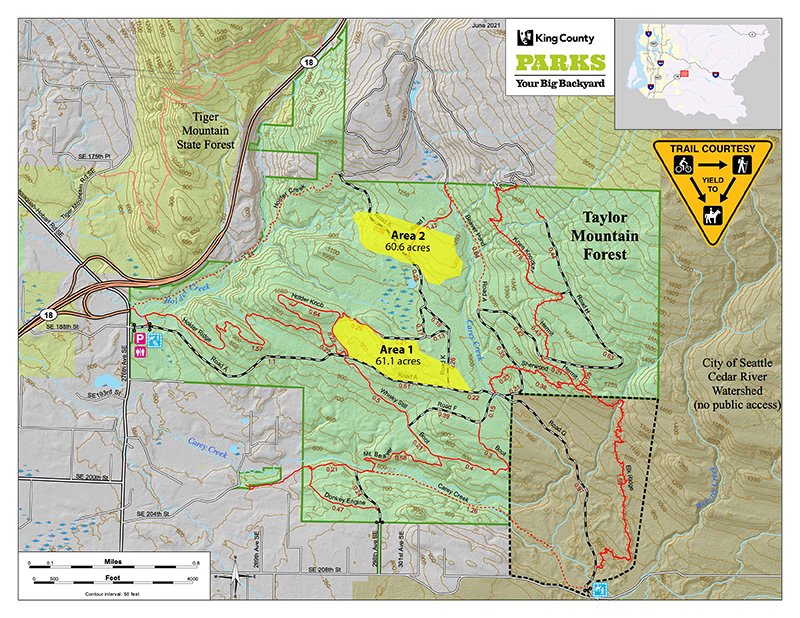Taylor Mountain: A roadmap for forest stewardship
Taylor Mountain: Then and Now
Taylor Mountain, often overshadowed by its popular Tiger and Cougar Mountain cousins, occupies 1,822 acres south of I-90 and east of SR-18. While it is less traveled than its Issaquah neighbors, Taylor Mountain still boasts views of Mt. Rainier and shelters black bears, cougars, and coho salmon.
Taylor Mountain is a lovely recreational destination, but it has undergone dramatic historical changes. Based on historical land surveys from the University of Washington, Taylor Mountain’s pre-European settlement tree composition was 80% conifer. Following extensive settlement and logging, that ratio had shifted to 80% hardwood, including maple, cottonwood, and alder. While these species are native to the Pacific Northwest, they are maladapted to climate change in comparison with the hardier and longer-lived conifers.
To address this imbalance, King County Parks held a public information session on April 11 (video here) to discuss its past actions and future plans and projections. In consultation with various partners, including the Issaquah Alps Trail Club, King County outlined its extensive forest stewardship plans across Taylor Mountain.
Forestry Priorities
The King County Department of Natural Resources outlined the forestry challenges and opportunities it faces on Taylor Mountain. Most importantly, the forest diverges from its historical composition due to decades of extensive clearcutting. Taylor Mountain has shifted in size, species diversity, species composition, ability to sequester carbon, and wildlife corridor layout. In its current iteration, Taylor Mountain is neither climate resilient, nor historically authentic, and is therefore a prime candidate for sustainable forestry.
Photo by Alexandra Machetanz
Taylor Mountain is also a working forest. This means that DNR has an additional objective of procuring sustainable timber harvests. With all these objectives in mind, DNR plans to remove nearly 100 acres of hardwood alder, cottonwood, and maple across two plots of land, measuring approximately 40 and 60 acres respectively. It will then replant, shifting the species composition to majority long-lived, climate-resistant, native conifers.
As discussed, the pre-European settlement composition of Taylor Mountain was 80% conifer. DNR plans to treat only 50% of Taylor Mountain over the next years, eventually restoring the makeup to around 60-65%. While it intends to remove 90% of the hardwoods, it will retain the biggest and longest-living maple and cottonwood.
Day-to-Day Impact
There will be temporary trail closures on Taylor Mountain as the two land plots transition for 1-3 years while DNR completes its logging and replanting efforts. In tandem with DNR’s restoration efforts, the County will also deliver six additional trail bridges, update existing trails, add a picnic and horse hitching station, and add an ADA accessible trail, all with the goal of improving user experience. Throughout this process, the County will work with IATC on the updated trail plan for Taylor Mountain.
Photo by Alexandra Machetanz
Frequent Taylor Mountain hikers, bikers, riders, and runners can check-out planned trail updates here. As discussed, forest restoration projects are important to maintaining healthy forests and restoring historical composition. King County has recently initiated similar projects on Cougar Mountain. Learn more about the Cougar gap treatment here.
Written for The Alpiner by Alexandra Machetanz



